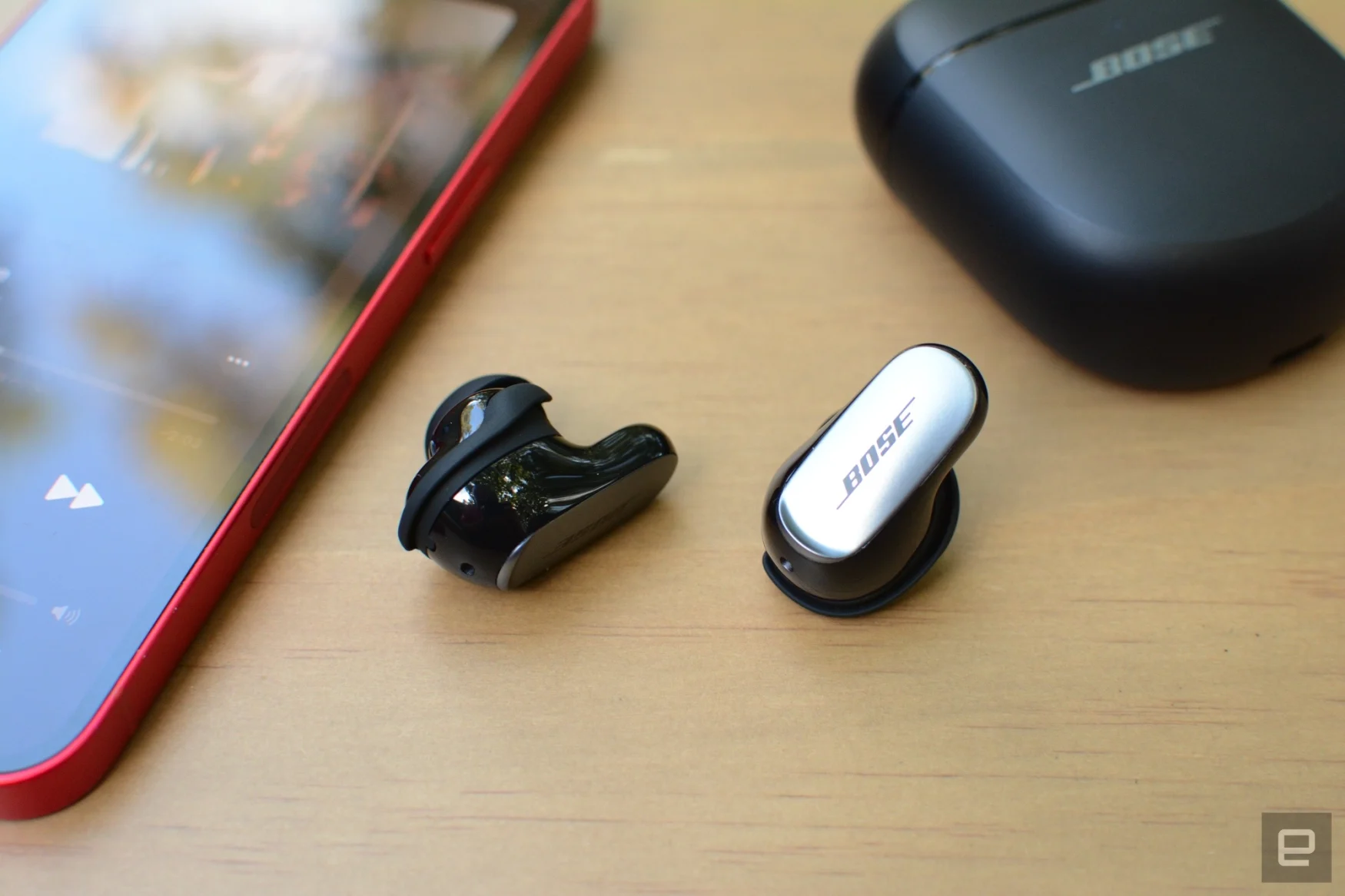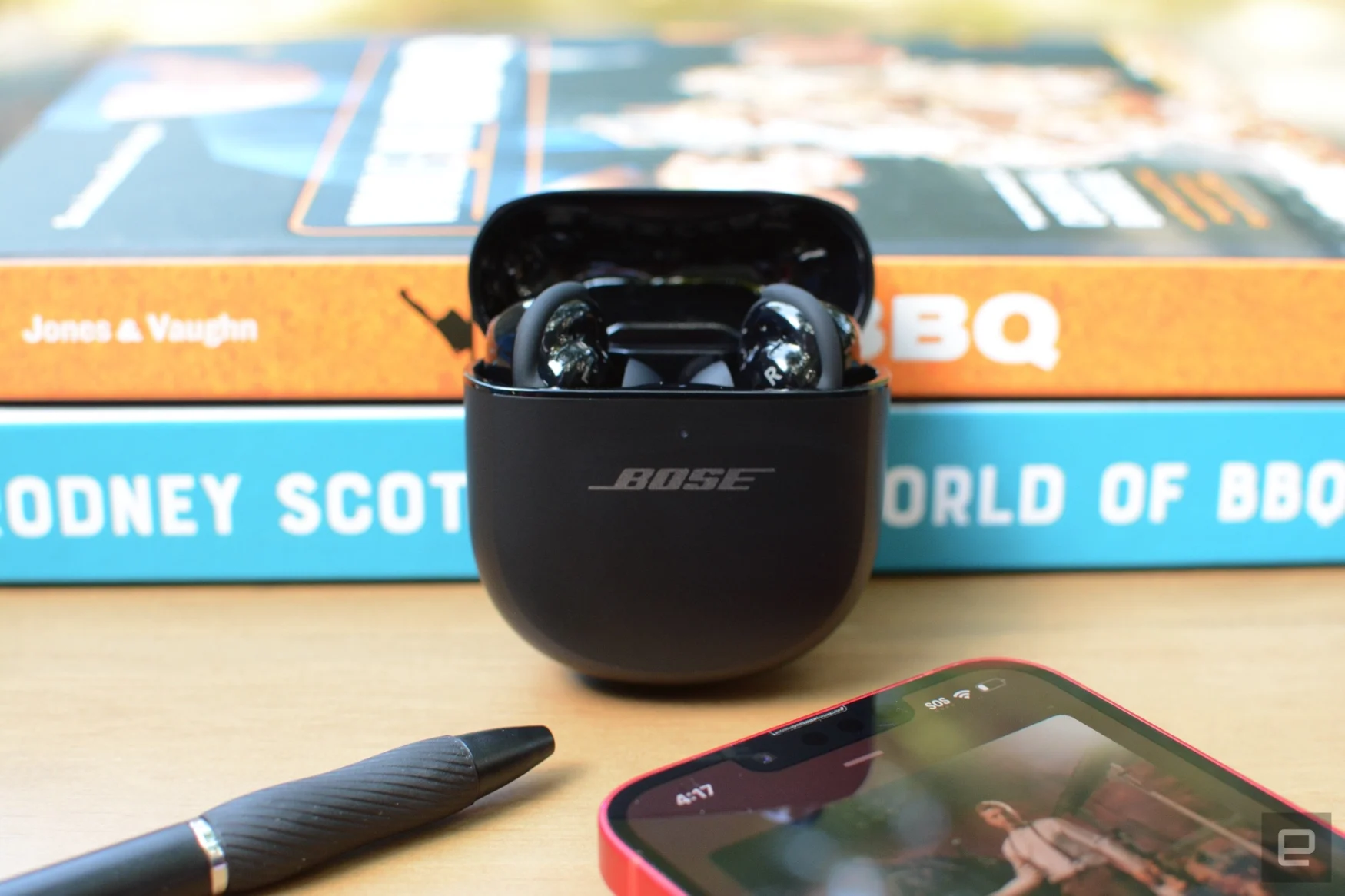Most earbud and headphone makers are starting to skip the annual update cycle. Sure, many of them release a new model regularly, but in terms of overhauling a previous product, the timelines are typically more extended. Bose has made an exception, choosing to reveal the QuietComfort Ultra Earbuds ($299) alongside its new QuietComfort Ultra Headphones a year after their predecessor. The new earbuds bring a familiar design and the same outstanding active noise cancellation (ANC), but the company is also promising a big boost in sound quality with its new Immersive Audio tech. For the same price as the set they replace, the QC Ultra Earbuds deliver spatial audio without the requirement, or the headache, of having to stream specialized content.
Bose made minimal changes to the design, retaining basically the same formula from the QuietComfort Earbuds II . One key difference is the touch panel on the outside, which is now silver instead of matching the earbuds (which were black, gray or white). It’s still plastic, but it’s just a different hue. Second, the company changed the “stability bands” or fit wings so they’re easier to properly install. That’s a welcome update since getting those securely in place was an issue on the QC Earbuds II.
With an almost entirely identical design from model to model, Bose didn’t reduce the size of the earbuds. This means they’re still quite large at a time when a lot of the competition continues to get smaller. However, the trade-off is the outer touch panel is larger than on tinier models from other companies. This translates to more reliable controls on the QC Ultra Earbuds and allows Bose to throw in a dedicated swipe gesture for volume adjustment, which is rare in this category.

All of the QuietComfort Ultra Earbuds’ features are accessible from the Bose Music app. Here, the company gives you battery percentages for each bud and a volume control at the top of the main screen. Below, you can access controls to toggle listening modes (ANC, transparency and Immersive Audio), the EQ, detailed settings, earbud seal test and options to reconfigure the shortcut gesture.
Under Immersive Audio, the app lets you switch between off, Still and Motion modes. They’re pretty self-explanatory, but I will point out that the Motion setting keeps the sound in front of you when you’re moving so music, movies and other content doesn’t stay in a fixed place or seem like it’s coming from behind or your pocket when you leave your desk. And since Bose lets you reconfigure the long press action on the earbuds, you can choose to have one side cycle through Immersive Audio modes while the other is set to shuffle through ANC (Quiet), transparency (Aware) and Immersive.
Bose’s new Immersive Audio is a big leap for sound quality on the company’s earbuds. The QuietComfort Earbuds II and the QuietComfort Ultra Earbuds both sound good right out of the box. But with this Ultra model and its spatial audio tech, Bose finally has the sonic chops to compete with comparable products from Sony and Sennheiser. And the best part is that you don’t need specially created content or a specific streaming service to unlock it. Immersive Audio works with everything, no matter where you’re playing it from.
Like most implementations of spatial audio, Bose’s version takes the stock tuning and makes it louder. There’s more presence to the sound, and noticeably more volume, but there’s also more clarity and detail. The company says it achieves this with virtualization tech that seeks to eliminate the sensation that sound from earbuds is inside your head. Instead, it makes it seem like you’re sitting in the “acoustic sweet spot” with speakers placed in front of you. The result is not only the feeling that you’re not wearing the earbuds at all, but also extremely natural-sounding audio that’s immersive without having to be dimensional to have an impact.
I noticed the biggest difference between the stock tuning and Immersive Audio on acoustic-driven albums like Zach Bryan’s self-titled release, Gregory Alan Isakov’s Appaloosa Bones and Noah Kahan’s Stick Season. All three are able to harness the effect of Bose’s spatial sound to the point that sometimes it seems like Zach Bryan is sitting right in front of you picking his guitar. When it’s just strings and a voice, you can really hear what Bose has achieved, but it doesn’t just work for folksy country or singer/songwriter ballads. You can clearly hear the influence of Immersive Audio throughout a range of genres, including metal, hip-hop and electronic tunes. At first you notice it’s louder, but after the initial jolt, the amplified details like texture in distorted guitars and synths, as well as reverb on the drums and layered instruments, become more apparent.

The QuietComfort Earbuds II have been our top pick for pure ANC performance in our best wireless earbuds guide since their debut. Bose has a long history of stellar noise cancellation and it’s still at the top of the heap. With the QuietComfort Ultra Earbuds, the company remains the best at blocking distractions, and these buds are especially good at reducing airplane noise to near silence during a flight. This new model struggles with voices, but that’s a pitfall of many earbuds and headphones. Still, when you encounter any kind of constant clamor, the QC Ultra Earbuds are likely your best choice if ANC effectiveness is top of mind.
Bose says it made improvements with dynamic microphone mixing and adaptive filters. According to the company, the QuietComfort Ultra Earbuds can also prioritize which earbud is getting the least wind interference while picking from a number of noise filters to keep you sounding clear – all in real time. During my tests, voice quality wasn’t exactly pristine, but the earbuds did a great job of blocking background sounds to reduce distractions. Is it the best? No. Will it get the job done with minimal fuss? Absolutely.
The new Immersive Audio tech will impact battery life, and Bose is upfront about that. The company says that with that spatial sound enabled, you can expect two hours less of playing time per charge. So instead of six hours with ANC, you’ll get around four, but that’s with noise cancellation and Immersive Audio turned on. During my tests, the QC Ultra Earbuds outperformed those estimates as the Bose Music app was still showing 30 percent left after four hours. What’s more, there are three additional charges in the case for a total of 16 to 24 hours of use.
The QuietComfort Earbuds II didn’t have wireless charging and the new model doesn’t either – at least not out of the box. If you want to top them up without a cable, you’ll have to buy a silicone cover for the charging case, which will cost an additional $50. Sure, it’s better than not offering wireless charging at all, but it would’ve been nice if the company had just built it into the product without requiring another component and an extra purchase.

Bose’s main competition for full-featured, noise-canceling earbuds is Sony, which debuted its WF-1000XM5 model in July, improving upon what was already a stellar formula. Simply put, no other company packs in as many features as Sony, and it manages to keep top-notch sound quality and ANC performance while doing so. The M5 is more expensive than previous models at $300, but that’s on par with the QC Ultra Earbuds. Sony also didn’t improve battery life from the M4, which is eight hours, and some of those handy features still need fine tuning.
For the Apple faithful, the second-gen AirPods Pro are also worth considering. Apple’s earbuds are loaded with features that make them the perfect companion for the iPhone and its other devices. The company has consistently put out the most natural-sounding transparency mode and new tricks enabled by the H2 chip, like Adaptive Audio, have made the year-old model even better. Great sound quality and solid ANC performance are also part of the appeal.
The QuietComfort Earbuds II were already the best true wireless model Bose had ever built, mostly due to their superior active noise cancellation. Add spatial audio that doesn’t require you to jump through any extra hoops to use and the QC Ultra Earbuds are immediately a worthwhile upgrade. Sure, there’s still work to be done on things like transparency mode, call quality and built-in wireless charging. But perhaps for the first time, Bose has a set of earbuds that can compete with the best sonically and not just purely on its noise-blocking merits.
© OfficialAffairs